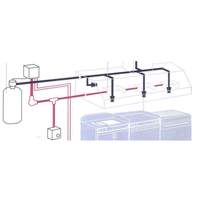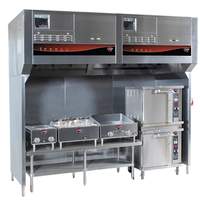An estimated 5,900 restaurant building fires are reported to U.S. fire departments each year. These fires cause, on average, 75 injuries and and an estimated $172 million in property loss, according to the FEMA Topical Fire Report Series. The cooking line is the leading cause of all restaurant building fires, which is why being prepared and having a proper restaurant fire suppression system is crucial.
When deciding on the right safety equipment and fire suppression system for your restaurant's kitchen, keep in mind the areas where fires are most likely to occur. The FEMA Restaurant Building Fires Report notes that the leading types of equipment involved in igniting non-confined - spreads beyond the source of ingition - restaurant building fires include deep fryers and ranges.
Hood systems
Grease hood systems are an important piece of proper fire prevention. Not just for fryers, grease hood systems are necessary to vent griddles and charbroilers as well. These hoods vent exhaust, smoke, steam, and other airborne particles to help control the kitchen environment and keep it safe. Depending on the size and structure of your kitchen, more than one hood may be required.
Fire suppression systems
Connecting to the hood, a fire suppression system will help to prevent fires from spreading when excessive smoke and flare-ups occur. This piped system is activated by high heat or can be turned on manually. A highly effective liquid-suppressing agent is sprayed on the area to extinguish the flames and cool grease when a certain temperature threshold is broken. The wet chemicals foam to seal combustible vapors and prevent re-ignition.
Fire suppression systems can be very effective at limiting fire damage to buildings as well as containing fires so workers and patrons can evacuate the establishment safely. Remember, fire suppression systems need to be approved by certified technicians before they are installed. It's best to hire a professional to ensure proper installation.
Inspection
A fire suppression system should be inspected often to make sure it works in case it's ever needed. A quality inspection can take up to an hour or more, as the technician will need to blow out the pipes in order to eliminate grease buildup. After the system has been certified, a tag with the date and other information for inspections will be provided.
If you have questions about adding a fire suppression system to your restaurant's kitchen or want information regarding other important safety initiatives, call the food industry experts at ACityDiscount at 404-752-6715.





